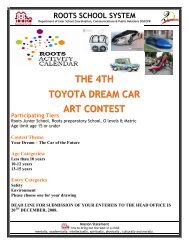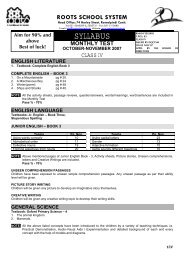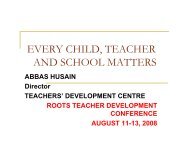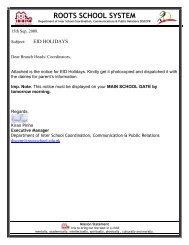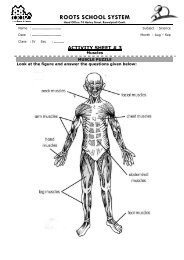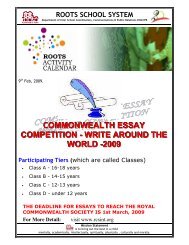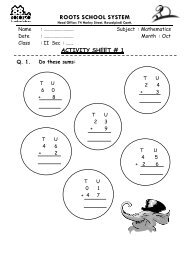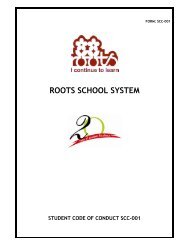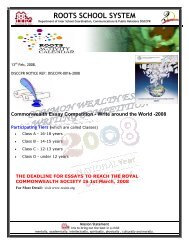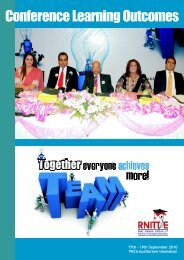Junior Montessori Download in PDF Format - Roots School System
Junior Montessori Download in PDF Format - Roots School System
Junior Montessori Download in PDF Format - Roots School System
You also want an ePaper? Increase the reach of your titles
YUMPU automatically turns print PDFs into web optimized ePapers that Google loves.
General Knowledge Lesson Plan from Play Group – Advanced <strong>Montessori</strong><br />
Expla<strong>in</strong> the relation of other family members i.e. fathers’ father is The other out l<strong>in</strong>e should be stapled and stuffed with news papers.<br />
grandfather etc.<br />
Activity 3: (Senses)<br />
Activity<br />
Taste:<br />
Invite any parent doctor <strong>in</strong> the assembly to expla<strong>in</strong> <strong>in</strong>ternal parts Prepare the tast<strong>in</strong>g tray <strong>in</strong>clud<strong>in</strong>g items like sugar, salt lemon and small piece of<br />
through charts and their functions.<br />
bitter gourd to experience and name the different type of tastes like sweet,<br />
salty, sour and bitter to be aware of different tastes.<br />
Expla<strong>in</strong> n detail about their muscles, bones, heart and <strong>in</strong>ternal parts of Smell:<br />
body.<br />
To give awareness about the sense of smell, different items like soap, empty<br />
Mighty Muscles: Muscles make our body move even when we bl<strong>in</strong>k our bottles of perfumes or dettol to be smelled by the students.<br />
eyes or snap our f<strong>in</strong>ger, or take a bite of food, we are putt<strong>in</strong>g our See<strong>in</strong>g:<br />
muscles to work. There are about 650 muscles that make up our body Develop their see<strong>in</strong>g sense by ask<strong>in</strong>g them to look about different objects <strong>in</strong><br />
muscle system. We can control most of these, such as our arms and their surround<strong>in</strong>gs i.e. fan etc.<br />
legs. These muscles move only when we deal with them. Other muscles, Bl<strong>in</strong>d fold activity can also be done to develop the regard and empathy towards<br />
such as our heart muscle, move without any direction by us.<br />
bl<strong>in</strong>d or any see<strong>in</strong>g deficiency child if any <strong>in</strong> the environment.<br />
Bones: Bones support our body if we did not have any bones we would Touch<strong>in</strong>g:<br />
look like a big blog – sort of like a jelly fish. Bones help us to move too. Take students outside the environment to observe and feel different types of<br />
They also protect our bra<strong>in</strong>, heart, lungs and other <strong>in</strong>ternal parts of textures by touch<strong>in</strong>g them like bark or trunk of the tree, leaves or sand or dry,<br />
body from gett<strong>in</strong>g <strong>in</strong>jured. Our skeletal system <strong>in</strong>cludes more than 200 clay, stones etc.<br />
bones. Bones are strong but hollow <strong>in</strong>side there a soft substance called Introduce the textures relevant vocabulary like hard, soft, pla<strong>in</strong>, rough, smooth<br />
marrow which is where new blood cells produced.<br />
etc.<br />
Senses tell us what someth<strong>in</strong>g looks like. What it smells like? Or what it Hear<strong>in</strong>g:<br />
sounds like? Senses are also used to f<strong>in</strong>d out what someth<strong>in</strong>g feels like Different voice pitches to be produced by the teacher to understand the<br />
or what it tastes like<br />
different hear<strong>in</strong>g vocabulary words like speak gently, speak softly, we should not<br />
The five senses are:<br />
be loud, yell<strong>in</strong>g etc.<br />
Sight, hear<strong>in</strong>g, touch, taste, smell<br />
(Nutrition)<br />
WEEK 7: (Nutrition)<br />
ALL LEVELS<br />
ALL LEVELS<br />
Nutrition eat<strong>in</strong>g right<br />
Activity 1: (Play Group & Jr. <strong>Montessori</strong>)<br />
Nutrition eat<strong>in</strong>g right<br />
Five groups of nutrition which are mentioned below<br />
Food gives the energy to our body. Eat<strong>in</strong>g right always help us to grow www.nutritionexplorations.org/images/catalog/books/elementary/ariannaposter<br />
strong and healthy. The best way to stay healthy is to eat a balanced<br />
diet .That means eat<strong>in</strong>g the right amount of food from each group every Children will paste empty wrappers, real objects or pictures of mentioned food<br />
day.<br />
groups’ items that are clearly mentioned <strong>in</strong> the above pictures.<br />
Most people eat three meals a day; breakfast, lunch and d<strong>in</strong>ner. Add<strong>in</strong>g<br />
two or three healthful snacks makes it easier to eat a balanced diet. Advanced <strong>Montessori</strong>:<br />
Some examples of healthful snacks are fruits, vegetables and low fat Along the above mentioned activity they will be <strong>in</strong>structed how to read a food<br />
snacks such as air-popped popcorn. Some foods are better for you than label that tell what is <strong>in</strong>side a box of biscuits and cheese. Use the <strong>in</strong>formation<br />
others. Watch out for snacks that conta<strong>in</strong> a lot of fat, sugar, or salt. listed on any food item and answer the questions that follow fill <strong>in</strong> the circle<br />
Salt is also called sodium. We need a small amount of fat <strong>in</strong> our diet but next to the correct answer





